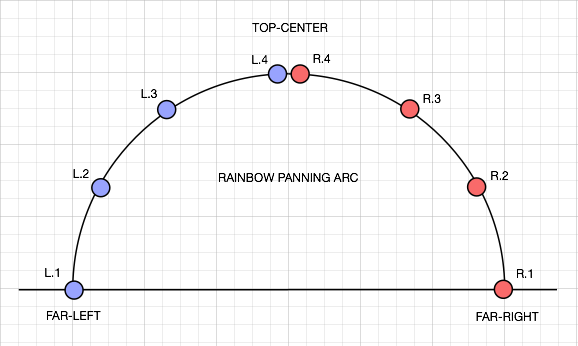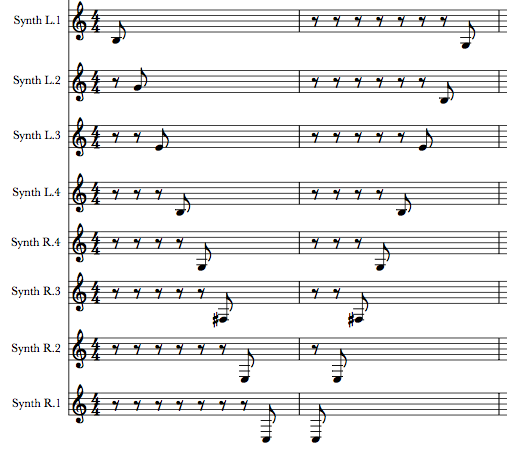G-Sun wrote:Wow,
answering with two excellent YouTube-tutorials. That's quite impressive!
(Are you a Notion employee or just like to help out a fellow user?)
Glad to help! 
I do not work for Notion Music, but I like to help folks, which also helps me, since I learn stuff by writing about it . . .
I suppose it is a bit unusual, but for example if I wanted to be a nuclear physicist, all I would need to do is to write a book about it, where the key aspect is that I do research and experiments when I am writing to ensure that what I write is as accurate as possible, which works nicely most of the time . . .
G-Sun wrote:Multi ch vsti: That's excellent info. Thank you!
There is a way to get ReWire 2 channel pairs for the various NOTION 4 Basic Staves, as shown in the following YouTube video tutorial that I made a while ago. I forgot about this and at the moment do not remember how I did it, but it clearly is something that can be done . . .
N4 K5 Multi Separate ReWire2 Channels ~ YouTube video tutorialG-Sun wrote:Leaves one question: If I need different noteheads for the single-line perc. Can I do that?
And if I like to explain my use of notheads, can I write that into the sheet somehow?
You can change the noteheads via the NOTION 4 Palette, and there probably are shortcut keys for it . . .

G-Sun wrote:1) [The copy and paste problem] seems like a bug to me . . .
It might be a "bug", but I have not encountered this behavior, so my advice is to do some experiments, which can include selecting the notes to copy a different way. Try selecting the notes one at a time, and try lassoing the notes . . .
G-Sun wrote:2) How do I take the second measure of the voice and make it voice2 (in same staff)?
So, it's no option to paste as voice2, or convert selected notes to voice2? I have to manually rewrite it into the score?
Once notes are in one voice, I think they stay in that voice, so the best strategy is to plan in advance how many voices you will have . . .
My perspective is that having more than one voice becomes very confusing, so I usually limit it to one voice and one VSTi virtual instrument per staff . . .
The primary problem is that the rests are not color-coded, so while the notes are color-coded, when there are rests for each voice, it gets a bit confusing very quickly . . .
Another reason for having one voice per staff is that I use NOTION 4 and VSTi virtual instruments to generate audio for songs and I have more control when I switch to producing and mixing when everything is separate, which includes having several staves of the same instrument but panned to different locations, which is something I do for kick drums, snare drums, and a few other instruments, which for example allows me to have a snare drum at far-left, top-center, and far-right in a way that I can control them separately and independently, which a useful for putting an instrument into motion . . .
Sometimes I spread the notes for a single instrument across as many as eight staves, where each stave is panned to a specific location on what I call the "Rainbow Panning Arc", which mostly makes sense when you listen to music with headphones. It takes a few hours, but I like the way it sounds, and I call it "sparkling" . . .


This is a Psaltery Harp from the Xpansion Tank "World Instruments Collection" (IK Multimedia), and it is "sparkled", as you can hear when you listen to it with headphones . . .
[
NOTE: This is possible because NOTION 4 has true stereo panning controls rather than the more simplistic stereo "balance" controls. For reference, a stereo "balance" control just adjusts the relative volume of the left and right channels but keeps the left on the left and the right on the right. In contrast, a true stereo panning control makes it possible to move left and right. However, it is not exactly the same as panning with two monaural or single-channel tracks, but it works nicely, so I like it. The panning is fine, but the problem is that the volume slider works both channels simultaneously. If the left channel is a kazoo and the right channel is a snare drum, you can pan them to different locations, but you always hear the kazoo and the snare drum. With two monaural tracks, you can pan them the same way, but you also can set the volume for the kazoo so that it is not heard, in which case you only hear the snare drum . . . ]
"Sparkles" (The Surf Whammys) ~ MP3G-Sun wrote:It's just a small tune for public school pupils. The score is most for me remembering my ideas. But later, I'll maybe present some basic power-point-stuff.
Starting up first time on monday as teacher, so, diving into the unknown

I think having NOTION makes everything easier and more logical, since for all practical purposes you can do on a computer what Bach and Mozart had to do with pen, ink, and paper and then hire an orchestra to hear how it sounded, although I think they probably knew how it would sound, except that hearing the music performed is different and at the time was a rare and expensive luxury afforded to only a small group of composers . . .
My perspective on music is that the most important thing is to make it FUN . . .
If you make it FUN, then students will absorb the information like sponges . . .
Lots of FUN! 
P. S. When I actually have a real music group, one of the first things I do is to have a bit of FUN with what appears to be a simple exercise in rhythm, and the reason I do this exercise is to emphasize the vast importance of rehearsing songs over and over and over, which tends to annoy some folks mostly because they do not understand why it is so important . . .
Even an apparently simple song has nuances that one does not understand fully until working with it for a while and as an example, if you do not have the patience and diligence required to play the same three note phrase over and over and over perhaps a few thousand times then music might not work so well for you. I lost count of the thousands of times I have played a simple 1-4 or 1-4-3 pattern on the high-pitch "
e" string of electric guitars, but at least for me this is the only way to be able to do it very rapidly . . .
[
NOTE: Among other things, this accomplishes two things: (a) it develops strength, dexterity, endurance, and all that stuff and (b) it creates new neural pathways in the brain and enhances the neural pathways to the various parts of the body involved in physically playing an instrument, including the singing apparatus, as well as the hearing apparatus . . . ]
This is an example of the FUN exercise and what each of five people does:
(1) The first person taps on a table or percussion instrument on every beat (
1-
1-
1-
1-
1 . . . )
(2) The second person taps on every other beat (1-
2-1-
2-1-
2 . . . ), tapping only on "
2" not "1" . . .
(3) The third person taps on every third beat (1-2-
3-1-2-
3 . . . ), tapping only on "
3" but not on "1" or "2" . . .
(4) The fourth person taps on every fourth beat (1-2-3-
4-1-2-3-
4 . . . ), tapping on on "
4" but counting silently on the "1-2-3" parts . . .
(5) The fifth person taps on every fifth beat (1-2-3-4-
5-1-2-3-4-
5 . . . ), tapping only on "
5" . . .
This appears to be an easy exercise, but it is
not so easy as it appears, even for skilled musicians . . .
The first person has the easy part, but the difficulty increases as the tap number increases . . .
In Joseph Schillinger's System of Musical Composition (SoMC), the rule is that the length of a measure is defined when everyone taps at the same time, which in the example (
see above) occurs when the "
1", "
2", "
3", "
4", and "
5" taps align, which is an interesting thing to ponder and is part of the concept of synchronicity . . .
This is part of an example where the numbers run from 1 through 7, and the number of beats in a single measure is in the hundreds, which is fabulous . . .
[
NOTE: This shows the music notation in NOTION as the song plays in real-time. I used a 4/4 time signature, since at the time I did not know you can write music notation in NOTION without any barlines. The number of beats in the correct measure is 420 and occurs at the end of the 105th 4/4 measure, which is a bit mind-boggling . . . ]
1-2-3-4-5-6-7 Rhythm Pattern ~ SoMC Techniques ~ YouTube music videoFabulous! 



